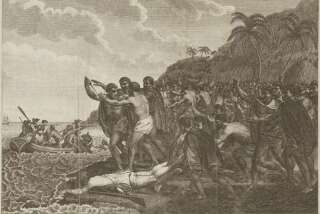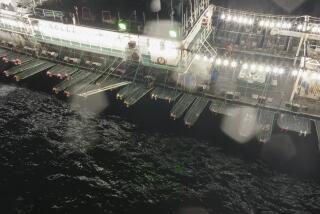Seaman’s Triumph, Tragedy Honored on Hawaiian Shore
KEALAKEKUA BAY, Hawaii — There’s some corner of a Hawaiian island that is forever England.
Those aren’t quite the words of the English poet Rupert Brooke, and the legalities may not be definitive, but the two-story-tall white obelisk overlooking Kealakekua Bay is enough, as far as the British navy is concerned.
Each time a Royal Navy vessel comes visiting, a work party goes ashore to wash and tidy up the monument and keep the memory of Capt. James Cook shipshape. All hands turn out on deck in dress whites, and a 10-gun salute echoes off the steep cliffs cradling lovely, crescent-shaped Kealakekua Bay.
Cook was killed here on his third remarkable world voyage in a senseless scuffle with the islanders who had worshiped him as a god. Nearly a century later, in 1877, when Hawaii was an independent kingdom, Princess Miriam Likelike gave the tiny plot to the British consul.
Frans Consen, captain of the Holland America liner Statendam, admires the British navy’s devotion. “That’s the British for you,” he said. “They have a long tradition for such things. I don’t think we Dutch would do it.”
But is the fenced-off postage stamp of land on the west coast of the Big Island really a part of the dwindling British empire? Legal experts conjecture it might take a murder on the spot to test who has sovereignty--London or Washington. And no murder is known to have been committed here since Feb. 14, 1779, when Cook, four British marines and 25 natives died in a melee over the theft of a small boat.
Kealakekua Bay was first charted by 22-year-old William Bligh, Cook’s sailing master aboard HMS Resolution, later the much-maligned captain of the Bounty.
Today it’s a state underwater park. A restored heiau, or native temple, on the pebbly black lava beach carries a sign saying KAPU--no trespassing--along with a plaque marking the burial place of 44-year-old gunner William Watman, who died in his hammock of a stroke. Here Cook conducted the first Christian service ever held in these islands, and also the first ecumenical one, with kahunas (priests) wailing incantations and tossing dead pigs and coconuts into the grave.
Watman’s death may have given the islanders the first clue that these visitors were less than gods.
Scuba divers now peek at parrotfish and spinning dolphins where the explorer anchored his ships, Resolution and Discovery. The monument is reachable only by fishing boat or a two-hour trek down a treacherous lava cliff path. A sign saying “If in doubt, don’t go out” warns kayakers of what Cook described as “the dreadful surf” and “thunderous reefs.”
Several months ago an Australian replica of HMS Endeavour, Cook’s flagship on his first global voyage, entered the bay in homage to the man who claimed the east coast of Australia for King George III in 1770.
Cook dropped anchor in Kealakekua Bay on his return to Hawaii after cruising the Alaskan coast and failing to find a northwest passage from the Atlantic to the Pacific.
On Jan. 18, 1778, European eyes for the first time beheld what Mark Twain called “the loveliest fleet of islands that lies anchored in any ocean.” At daybreak midshipman James Ward, aloft in ship’s rigging, sang out “land ho” as the peaks of Oahu loomed above the clouds. Soon two more islands appeared on the horizon.
Next morning off Kauai, dozens of canoes, some double-hulled, battled through the breakers. Cook lowered a bag of nails and was repaid with a catch of mackerel.
“Some took courage and ventured aboard,” Cook wrote in his journal. “I never saw Indians so much astonished at entering a ship. Their eyes were continually flying from object to object.”
Right off, he was introduced to the hallowed Hawaiian custom of cheerfully ripping off the tourists. The islanders prized metal that washed up from distant shipwrecks to fashion fishhooks, spears and daggers, and Cook’s ships looked like the jackpot.
A man came aboard, “stole the butcher’s cleaver, leaped overboard, got into his canoe and made for shore,” Cook wrote. Another tried to steal the lead line, a 14-pound lead ball attached to a measured rope, which was then a navigator’s indispensable depth finder.
“If Cook lost that, he would have had little else,” Capt. Consen notes. “Our bridge has many navigation devices, like an echo sounder sending up signals from the bottom. Cook would have had to keep a lookout on the bow, but with the refraction of light off the coral patches he really couldn’t tell how deep it was--100 meters or two meters.”
Cook sent three boats ashore “to look for a landing place and fresh water.” In command was Lt. John Williamson. He panicked and shot a native dead when dozens swarmed around eager to grab “everything they could lay hold upon.”
Williamson later was drummed out of the Royal Navy for cowardice. Cook hastened to establish peaceful relations. “The very instant I leaped ashore,” he related, “they all fell flat on their faces and remained in that humble posture till I made signs for them to rise.”
To native eyes, these malihinis--strangers--in the funny three-cornered hats had triangular heads and breathed fire from the pipes in their mouths.
Like today’s cruise passengers, the visitors went on a shopping spree. “By exchanges of nails and pieces of iron,” they acquired “about 60 or 80 pigs, a few fowl, a quantity of potatoes and a few plantains and taro roots.”
Cook was acclaimed not just for his seamanship but his hygiene measures. He had just been honored for preventing scurvy on long voyages. This he achieved by regularly airing all living quarters and by cutting off grog rations of any sailor failing to wash his hands before meals.
When citrus fruits ran low, he persuaded the crew to eat sauerkraut.
To avoid spreading gonorrhea on the shores his ships visited, he banned women from coming aboard, and sailors with “the venereal distemper” from disembarking.
This master navigator, who added more names to the world map than any other in history, named his latest find the Sandwich Islands in honor of his boss, First Lord of the Admiralty John Montagu, Fourth Earl of Sandwich, a corrupt bureaucrat famous only for inventing the modern-day snack that bears his title.
The pounding surf limited Cook to three trips ashore in 14 tries, so he weighed anchor and headed for the Arctic.
Eight months later, his ships battered by blizzards and ice floes, Cook returned to Hawaii for resupplying. It was his fate to arrive during Makahiki, a two-month feast dedicated to Lono, the god of harvests. Native belief held that Lono would arrive someday on his floating island. The two tall ships entering Kealakekua Bay fitted the legend.
As thousands lined the cliffs chanting “Lono, Lono,” a flotilla of outrigger canoes came out with gifts “of hogs and women.”
This time “it was not possible to keep the latter out of our ships,” the captain wrote. “No women I ever met were more ready to bestow their favors. Indeed it appeared they came with no other view.”
Terreeoboo, a high chief “of great girth,” invested Cook with a magnificent cloak of feathers, which is now in the British Museum.
The captain gave him a linen shirt and his cutlass. They pledged undying friendship. Cook went ashore, and again the islanders fell on their faces. For days villagers from all over the Big Island brought out the best of their harvest.
But inevitably, after 16 days the foreigners wore out their welcome. They set sail, only to be forced back when a storm split Resolution’s main mast. Now the mood of the islanders turned decidedly surly. Thefts increased. Stones were hurled at landing parties.
Lt. James King’s journal picks up where Cook left off. Before dawn on Feb. 14 a small boat was stolen from Discovery. Cook went ashore with 10 marines to take Terreeoboo hostage until the cutter was returned.
A crowd gathered, menacingly clacking stones and humming war chants. Some donned spear-proof matted vests. Suddenly musket fire erupted on the far side of the bay, and word spread that “a chief of the first rank” had been killed.
A warrior with a spear threatened Cook, who had loaded one barrel of his gun with harmless birdshot and the other with lethal iron balls. The birdshot impressed nobody, and when another warrior tried to stab the marine commander, Cook fired his second barrel and killed a native.
Before the marines could reload, the crowd “broke in upon them with dreadful shouts and yells,” Lt. King wrote. Cook was clubbed, repeatedly stabbed, and fell face down in the water. He might have made it to a nearby boat, but he couldn’t swim.
“Thus fell our great and excellent commander,” lamented King. The Hawaiians made off with the body to accord it honors due only to the highest chieftain. They dismembered it, burned the flesh from the bones in a luau oven and distributed the parts among the important chiefs.
Years later an old man told the missionaries that as a 5-year-old he found Cook’s heart hanging in a hut and “ate it in the mistaken belief it was a dog’s.”
Now in command, Discovery Capt. Charles Clerke shelled the island’s grass shacks to make the natives return Cook’s body parts for burial. On Feb. 22 the bell of the Resolution tolled, ensigns were lowered to half-mast and cannons on both ships thundered a 10-gun salute as “the remains of Capt. Cook were committed to the deep.”
George III wept when the news reached London.
The ugly final act did not dim Cook’s memory or the popularity of the British in the islands. For years the old chief went about in the captain’s linen shirt, flourishing his cutlass. High priest Koa changed his name to “Britanee.” More than a decade later, Capt. Bligh and his Bounty crew found the Tahitians sacrificing suckling pigs to a portrait of Cook left by some passing ship, dancing and chanting “all hail Cook, chief of air, earth and water.”
Their royal majesties on opposite sides of the world kept in touch. King Kamehameha II and his queen made a state visit to George IV and died of measles in London. King Kalakaua on his world tour had tea with Queen Victoria.
More to Read
Sign up for The Wild
We’ll help you find the best places to hike, bike and run, as well as the perfect silent spots for meditation and yoga.
You may occasionally receive promotional content from the Los Angeles Times.






